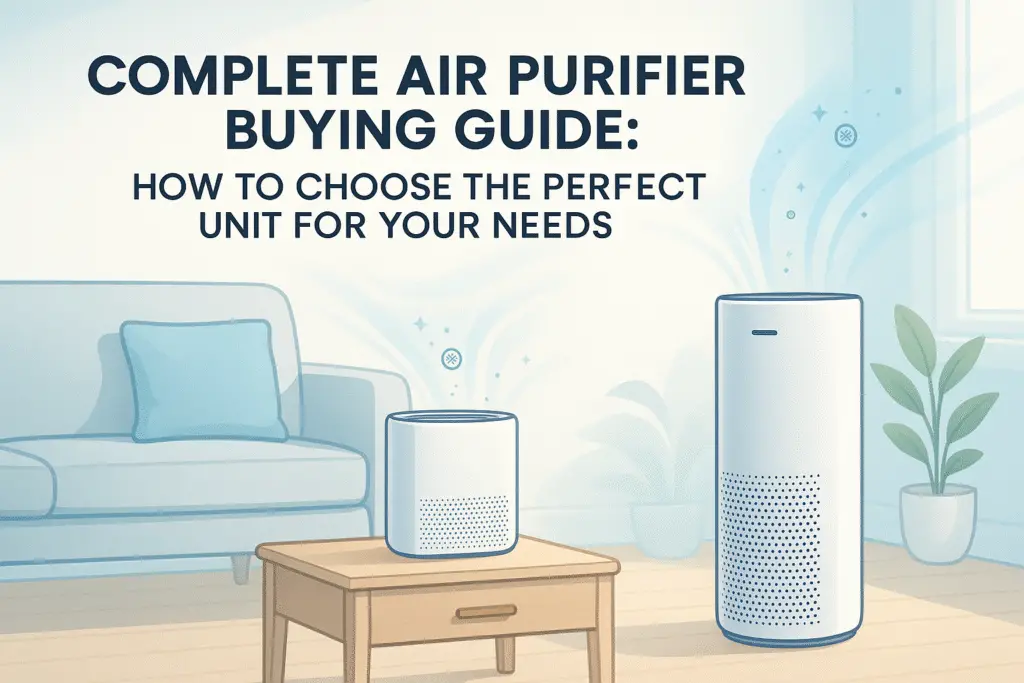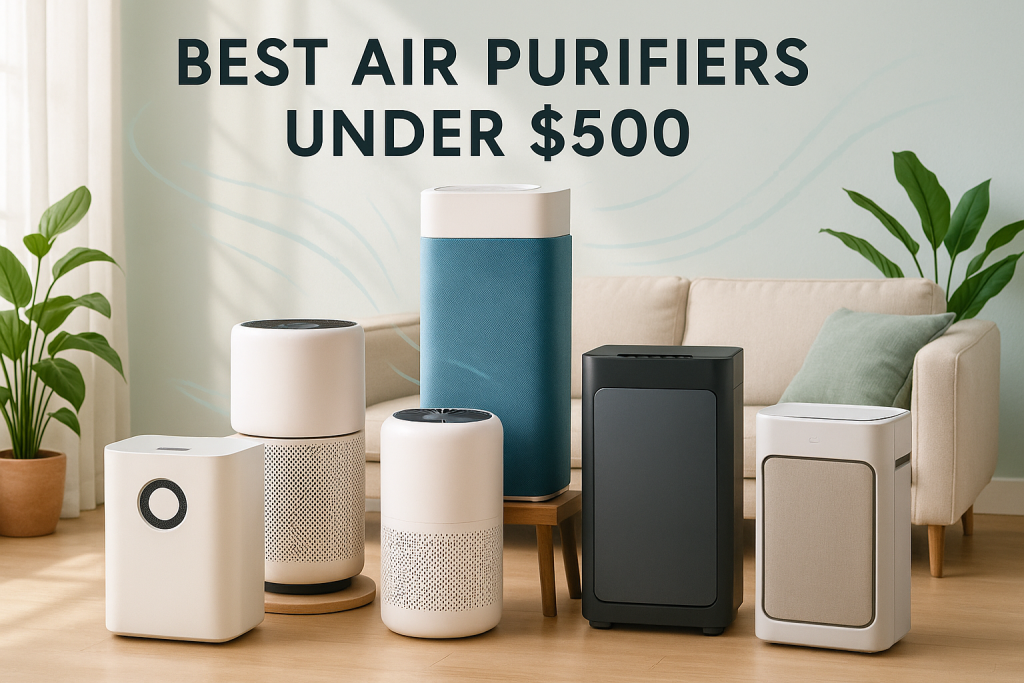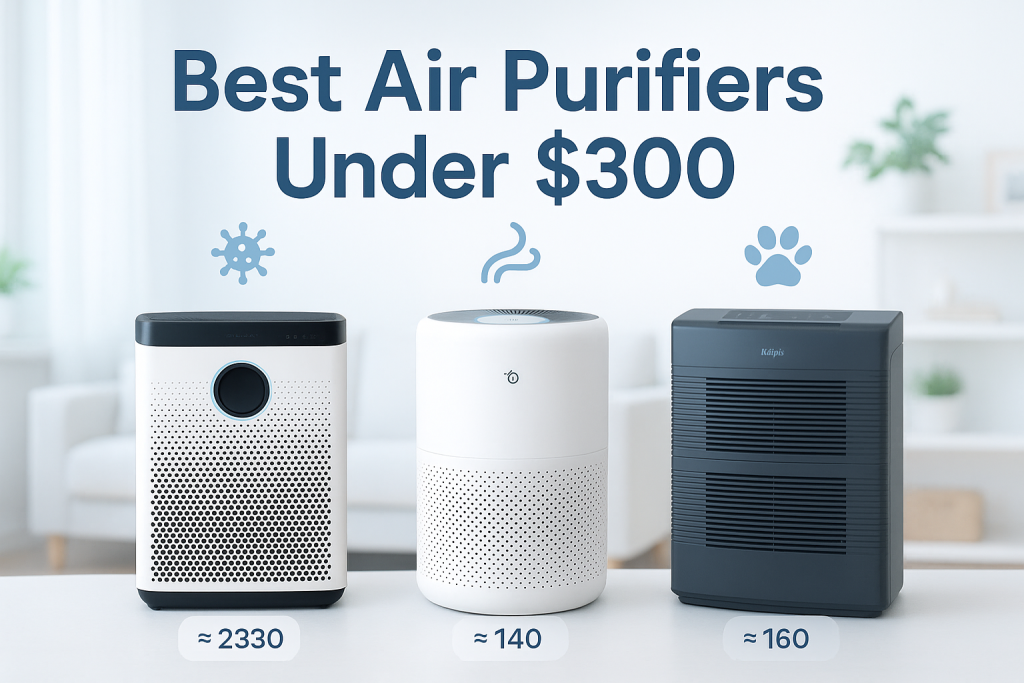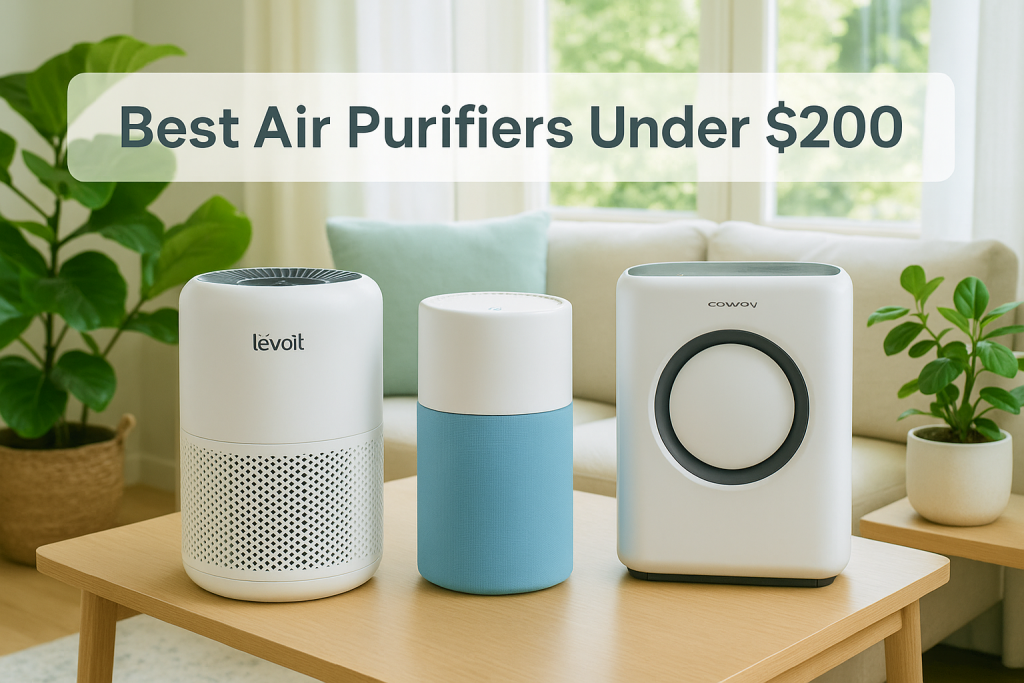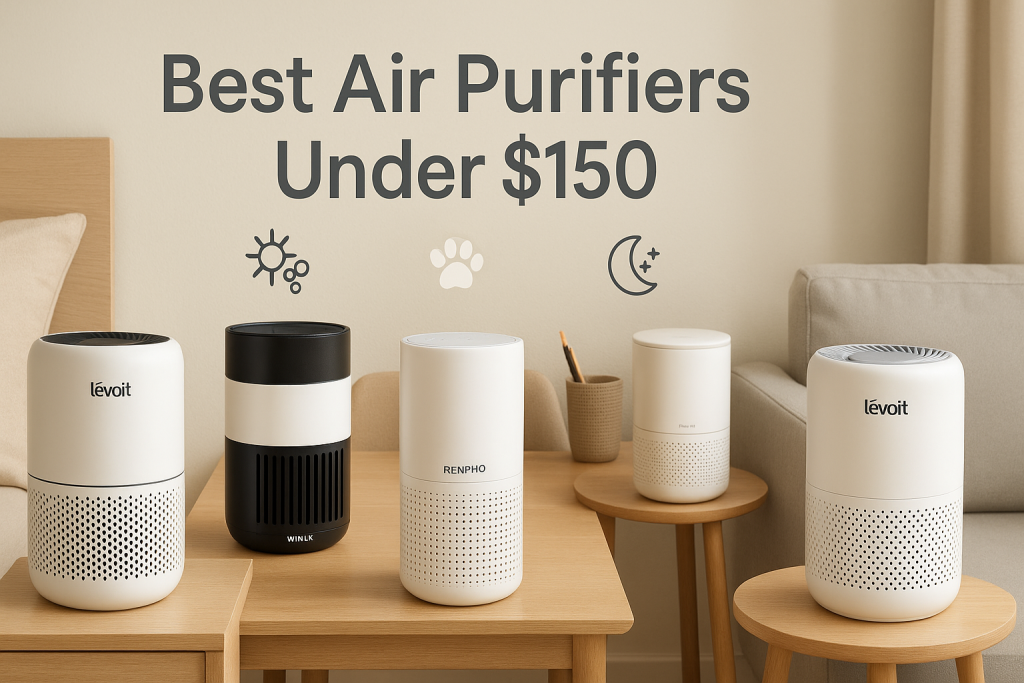An air purifier is a device that removes contaminants from indoor air, improving air quality and helping people breathe easier. With rising concerns about indoor air pollution, allergies, and respiratory issues, finding the right air purifier has become essential for many households. This comprehensive guide will walk you through everything you need to know to select the perfect air purifier for your specific situation.
Indoor air can contain numerous pollutants – from dust and pet dander to mold spores and volatile organic compounds (VOCs). According to the EPA, indoor air can be 2-5 times more polluted than outdoor air. The right air purifier can significantly reduce these contaminants, providing cleaner air and potential health benefits.
By the end of this guide, you’ll understand different air purification technologies, how to match features to your specific needs, proper sizing for your space, and important maintenance considerations. Whether you’re concerned about allergies, pet odors, or general air quality, you’ll have the knowledge to make an informed decision.
Understanding Air Purifier Technology: How Different Types Work
Before choosing an air purifier, it’s essential to understand the different technologies available and how each addresses specific air quality issues. Each purification method targets different pollutants with varying levels of effectiveness.
| Photo | Popular Air Purifiers | Price |
|---|---|---|

|
Air Purifiers for Home Large Room up to 1500ft², Tailulu H13 True HEPA Air Purifier for Pets Dust Odor Smoke, Air Purifier for Bedroom with 15dB Quiet Sleep Mode for Bedroom Office Living Room | Check Price On Amazon |
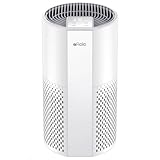
|
Afloia Air Purifier for Home, 4-in-1 Washable Filter for Allergies, Covers Up to 1076 ft², Quiet Operation, Auto Shut-Off & Night Light, Removes Pet Dander, Pollen, Dust, Mold, and Smoke, White,Pluto | Check Price On Amazon |

|
Nuwave OxyPure ZERO Air Purifier with Washable and Reusable Bio Guard Tech Air Filter, Large Room Up to 2002 Ft², Air Quality Monitor, 0.1 Microns, 100% Capture Irritants like Smoke, Dust, Pollen | Check Price On Amazon |

|
Air Purifiers for Home Large Room Up to 1,996 Ft², EOEBOT Air Purifier for Home Pets with Washable Filter, Quiet Sleep Mode, Air Quality Monitor, Air Purifier for Bedroom, Pet Hair, Dust, Smoke, White | Check Price On Amazon |

|
Afloia 2 IN 1 Air Purifier with Humidifier Combo, 3-Stage Filters for Home Allergies Pets Hair Smoker Odors, Evaporative Humidifier, Auto Shut Off, Quiet Air Cleaner with Seven Color Light,White | Check Price On Amazon |
Air purifiers use various technologies that work in fundamentally different ways. Some physically trap particles, others use electrical charges, and some employ light or chemicals to neutralize contaminants. Understanding these differences is crucial for selecting the right unit for your specific concerns.
HEPA Filtration: The Gold Standard Explained
HEPA (High-Efficiency Particulate Air) filtration is considered the gold standard in air purification technology, but what exactly does “HEPA” mean, and why is it so effective?
True HEPA filters must capture at least 99.97% of particles as small as 0.3 microns in diameter. This specific size (0.3 microns) is used as the standard because it’s the most difficult particle size to capture – particles both larger and smaller are actually easier to trap. For perspective, human hair is about 50-70 microns thick, so HEPA filters capture particles far smaller than what’s visible to the naked eye.
Different grades of HEPA filtration include:
- True HEPA: Meets the official standard of capturing 99.97% of 0.3-micron particles
- HEPA-type or HEPA-like: Less efficient filters that don’t meet the true HEPA standard
- Medical-grade HEPA: Even more efficient filters (H13 or H14) that capture 99.95-99.995% of particles
HEPA filters work through several physical mechanisms, including interception, impaction, and diffusion. They excel at capturing:
- Dust and dust mites
- Pollen
- Pet dander
- Mold spores
- Most bacteria
However, HEPA filters do not capture gases, odors, or VOCs. This is why comprehensive air purifiers often combine HEPA with additional filtration technologies.
Activated Carbon and Specialized Filters
While HEPA filters excel at capturing particles, they don’t effectively remove gases, odors, or volatile organic compounds (VOCs). This is where activated carbon and specialized filters become essential.
Activated carbon works through adsorption – a process where gas molecules adhere to the surface of the carbon. The carbon is “activated” through a special process that creates millions of microscopic pores, dramatically increasing its surface area. Just one gram of activated carbon can have a surface area exceeding 3,000 square meters.
Activated carbon effectively removes:
- Cooking odors
- Pet smells
- Smoke odors
- Common household VOCs (from cleaning products, paints, etc.)
- Some chemicals and gases
The effectiveness of carbon filtration depends largely on the amount of carbon used. Budget air purifiers might contain as little as a few ounces, while premium models may include several pounds of carbon. More carbon generally means better odor removal and longer filter life.
For specific chemical concerns, some manufacturers offer specialized filters targeting formaldehyde, ammonia, or other specific compounds. These typically use additives or treated carbon to enhance removal of particular gases.
Air Ionization and Electrostatic Technologies
Ionizers and electrostatic purifiers use electrical charges to remove particles from the air, but come with important considerations regarding safety and effectiveness.
Air ionizers work by releasing negatively charged ions into the air. These ions attach to airborne particles, giving them a negative charge. The charged particles then attach to positively charged surfaces in the room (walls, furniture, floors) or to collector plates in the purifier.
Electrostatic precipitators work similarly but pull the charged particles back into the unit where they collect on charged plates. These systems require regular cleaning of the collection plates to maintain efficiency.
Important safety consideration: Some ionizers produce ozone as a byproduct, which can irritate the lungs and worsen asthma symptoms. The EPA warns against devices that intentionally produce ozone, as ozone is a lung irritant that can cause adverse health effects.
Modern bipolar ionization technologies claim to produce fewer harmful byproducts while offering benefits like reducing airborne pathogens. However, these technologies have less independent research supporting their effectiveness compared to HEPA filtration.
Ionization and electrostatic technologies can be appropriate in some situations, particularly when particle recirculation is a concern, but they generally shouldn’t be the primary filtration method for those with respiratory issues.
Matching Air Purifier Features to Your Specific Needs
The best air purifier for you depends on your specific situation. This section will help you identify which features matter most based on your particular concerns and living situation.
Everyone’s air quality concerns are different. A person with severe allergies has different needs than someone primarily concerned with cooking odors or wildfire smoke. By matching specific features to your situation, you can ensure you’re not paying for unnecessary features while getting the protection you need.
For Allergy and Asthma Sufferers: Critical Features
If you suffer from allergies or asthma, your air purifier selection should prioritize certain features that specifically address respiratory triggers.
Allergies and asthma can be significantly impacted by indoor air quality. According to the Asthma and Allergy Foundation of America, indoor allergens are among the most common triggers for symptoms. An effective air purifier can remove many of these triggers from your air.
Priority features for allergy and asthma sufferers:
- True HEPA filtration: Essential for capturing common allergens like pollen, dust mites, and pet dander
- High CADR rating: Ensures sufficient air cleaning capacity for your room size
- Sealed system design: Prevents air from bypassing the filter
- Air quality sensors: Automatically increases purification when allergen levels rise
- Filter replacement indicators: Ensures you’re not running with ineffective filters
- Certified asthma & allergy friendly: Look for certification from AAFA
Research published in the Journal of Asthma found that HEPA air purifiers can reduce asthma symptoms and improve quality of life for sufferers. For maximum benefit, run your purifier continuously, especially in bedrooms where you spend 6-8 hours daily.
For Homes with Pets: Dander and Odor Control
Pet owners face unique air quality challenges, including dander (a common allergen) and pet odors that standard air purifiers may not fully address.
While we love our furry friends, pets contribute significantly to indoor air quality issues. They shed dander (tiny skin flakes), hair, and can bring in outdoor allergens on their fur. Many pets also create odors that can permeate a home.
Essential features for pet owners:
- Combination HEPA and robust carbon filtration: HEPA captures dander while carbon addresses odors
- Strong pre-filter: Captures pet hair before it clogs the main filter
- Higher air change rate: Look for units that can perform 4-5 air changes per hour
- Washable pre-filters: Allow easy cleaning of accumulated pet hair
- Quiet operation: Important for noise-sensitive pets
Strategic placement is crucial in homes with pets. Position units in areas where pets spend the most time. For multiple pets, consider using several smaller units rather than one large unit. Remember that even the best air purifier supplements rather than replaces regular vacuuming and cleaning.
Understanding Air Purifier Specifications and Ratings
Air purifier specifications can be confusing, but understanding these ratings is crucial to making an informed decision. Here’s what each specification actually means for real-world performance.
Manufacturers use various metrics to describe their air purifiers’ performance. These numbers directly impact how well the unit will work in your space. Learning to interpret these specifications will help you see through marketing claims and understand true performance potential.
CADR Ratings: What They Mean and Why They Matter
CADR (Clean Air Delivery Rate) is the most important metric for comparing air purifier performance, but many consumers don’t understand how to interpret these numbers.
CADR ratings are usually the most reliable indicator of an air purifier’s effectiveness. Developed by the Association of Home Appliance Manufacturers (AHAM), CADR measures how much filtered air an air purifier delivers. The higher the CADR, the more air the unit filters.
CADR is expressed in cubic feet per minute (cfm) and is typically provided for three common pollutants:
- Dust: Measures effectiveness against small particles like dust
- Pollen: Measures effectiveness against larger particles like pollen
- Smoke: Measures effectiveness against very small particles like smoke
For example, an air purifier with a dust CADR of 200 cfm can reduce dust concentration at the same rate as adding 200 cubic feet per minute of clean air.
To determine if a purifier is appropriate for your room size, use the 2/3 rule: The CADR should be at least 2/3 of your room’s square footage. For a 300 square foot room, look for a smoke CADR of at least 200.
| Room Size | Minimum Recommended CADR |
|---|---|
| Small (up to 150 sq ft) | 100 cfm |
| Medium (150-300 sq ft) | 200 cfm |
| Large (300-500 sq ft) | 350 cfm |
| Very Large (500+ sq ft) | 450+ cfm |
Remember that higher CADR ratings often come with increased energy usage and noise, so the highest CADR isn’t always the best choice for every situation.
Sizing Your Air Purifier: Matching Capacity to Room Dimensions
Choosing the correct size air purifier is perhaps the most crucial decision you’ll make. An undersized unit will struggle to clean your air effectively, while an oversized one may consume unnecessary energy and create excess noise.
Getting the size right ensures your air purifier can adequately clean your space while operating efficiently. Many air quality issues result simply from using an underpowered purifier for the space.
Follow these steps to properly size your air purifier:
- Measure your room dimensions: Multiply length × width to get square footage (e.g., 12ft × 15ft = 180 sq ft)
- Account for ceiling height: For ceilings higher than 8 feet, increase your square footage by 25% for each additional 2 feet of height
- Determine required CADR: Multiply your square footage by 2/3 to find your minimum CADR rating (e.g., 180 sq ft × 2/3 = 120 CADR)
- Consider air changes per hour: For general use, 4-5 air changes per hour is recommended. For allergies or asthma, aim for 6+ air changes per hour
- Adjust for open floor plans: If your space opens to other rooms, you’ll need to account for the larger effective area
For homes with open floor plans, you have two options: choose a larger unit with sufficient CADR for the entire open area, or use multiple smaller units strategically placed throughout the space. Multiple units often provide better overall air quality than a single large unit.
Strategic Placement for Maximum Effectiveness
Where you place your air purifier significantly impacts its effectiveness. Even the most powerful unit will underperform if positioned incorrectly.
Proper placement ensures optimal airflow and maximum contaminant capture. Air purifiers work by drawing in air, cleaning it, and releasing it back into the room. Positioning affects how efficiently this process works.
Best practices for air purifier placement:
- Maintain clearance: Keep at least 2 feet of space on all sides where air is drawn in
- Avoid corners: Placing units in corners restricts airflow significantly
- Position near concerns: Place units closer to known pollution sources (kitchen, cat litter, etc.)
- Bedroom placement: Position units 6-10 feet from the bed, ideally with airflow directed toward you
- Avoid high humidity areas: Keep units away from bathrooms and direct water exposure
- Elevate smaller units: For tabletop units, placing them 3-5 feet off the ground improves air circulation
- Keep away from electronics: Some purifiers can cause interference with TVs and radios
For multi-story homes, prioritize upstairs bedrooms since air naturally rises, bringing contaminants from lower floors. In living areas, central placement with good clearance works best, even if it means the unit is more visible.
Maintenance Requirements and Long-Term Costs
The purchase price is just one part of the total cost of owning an air purifier. Understanding maintenance requirements and ongoing expenses will help you make a more informed decision.
Many consumers focus solely on the initial purchase price, overlooking significant long-term costs. Over a 5-year period, maintenance and operation can actually exceed the original purchase price for many models.
The primary ongoing expenses include:
- Filter replacements: The most significant recurring cost
- Electricity consumption: Varies widely between models
- Additional parts: Some units require replacement of UV bulbs or ionizer wires
A typical 5-year cost comparison might look like this:
| Expense Category | Budget Model ($100) | Mid-Range Model ($250) | Premium Model ($500) |
|---|---|---|---|
| Initial Purchase | $100 | $250 | $500 |
| Filter Replacements | $180 (3×$60/year) | $300 (2×$150/year) | $500 (1×$100/year) |
| Electricity (5 years) | $350 (70W unit) | $250 (50W unit) | $200 (40W unit) |
| 5-Year Total | $630 | $800 | $1,200 |
This example illustrates why considering long-term costs is essential. The budget model actually costs more to operate than the mid-range model over time, despite its lower initial price.
To reduce long-term costs, look for Energy Star certified units, which typically consume 40% less energy than standard models. Some manufacturers also offer filter subscription services at reduced rates.
Filter Replacement: Schedules, Costs, and Best Practices
Filter replacement is the most significant ongoing expense for most air purifiers. Understanding the real costs and proper procedures will help you maintain optimal performance and manage expenses.
Different types of filters have varying lifespans and costs. Manufacturers’ replacement recommendations typically assume normal conditions, but homes with pets, smokers, or high pollution levels will need more frequent replacements.
Typical replacement schedules and costs:
- Pre-filters: 3-6 months, $10-30 each (some are washable)
- HEPA filters: 6-12 months, $30-100 each
- Carbon filters: 3-6 months, $20-50 each
- Combination filters: 6-8 months, $50-150 each
Signs your filter needs replacement even if not scheduled:
- Visibly dirty or discolored filter surface
- Decreased airflow from the unit
- Unusual odors from the purifier
- Increased allergy symptoms or respiratory issues
- Unit running louder than normal
Filter replacement best practices include keeping replacement filters sealed in their packaging until needed, washing hands before handling new filters, and properly disposing of old filters in sealed bags (especially important for those with allergies).
Many manufacturers now offer automatic filter delivery subscriptions, which can save 10-15% on replacement costs while ensuring you don’t forget to replace filters on schedule.
Smart Features and Connectivity: Worth the Premium?
Modern air purifiers often come with smart features and connectivity options that command premium prices. Are these features worth the additional cost?
Smart features typically add $50-150 to the base price of an air purifier. While these features offer convenience and additional functionality, they’re not essential for the core air-cleaning function. Determining their value requires considering your specific needs and usage patterns.
Common smart features include:
- Air quality sensors: Detect pollutant levels and adjust operation automatically
- Smartphone apps: Control the unit remotely and monitor air quality
- Voice assistant integration: Control via Amazon Alexa, Google Assistant, etc.
- Scheduling: Program operation times for different days/hours
- Filter life monitoring: Track actual filter usage rather than just time
- Usage reports: Data on air quality trends and purifier performance
Pros and cons of smart features:
| Pros | Cons |
|---|---|
| Automatic adjustment to air quality changes | Higher initial cost |
| Convenience of remote control | Potential privacy concerns with connected devices |
| More efficient operation (running at high speed only when needed) | Additional potential points of failure |
| Filter replacement based on actual use, not just time | May require home WiFi network to function fully |
| Air quality history helps identify problem times/activities | Some features require ongoing subscriptions |
Smart features provide the most value for those who: want automatic adjustment to changing conditions, frequently adjust settings based on activities, want to monitor air quality trends, or need remote control when away from home.
For those primarily concerned with basic air cleaning on a budget, a non-smart model with manual controls will provide the same level of air purification at a lower price point.
Air Purifiers for Specific Situations and Environments
Beyond general home use, certain situations demand specialized air purification approaches. This section addresses specific environments and circumstances that require tailored solutions.
Different living situations present unique air quality challenges that affect purifier selection. The ideal solution for a studio apartment differs significantly from what works best in a large house or during environmental emergencies.
Small Apartments and Studios (under 500 sq ft)
In compact living spaces, noise, size, and all-in-one functionality become critical. Look for:
- Compact units with small footprints but high CADR-to-size ratios
- Lower noise levels (under 50 dB on high settings)
- Multi-stage filtration handling multiple pollutant types
- Energy efficiency to minimize impact on utility bills
Large Open Floor Plans
Open concept homes require different strategies than compartmentalized spaces:
- Consider multiple smaller units rather than one large unit
- Focus purification in most-used areas
- Look for units with higher fan speeds and air circulation capabilities
- Central HVAC filtration upgrades may complement room purifiers
Basements and High-Humidity Environments
These areas often have specific air quality issues:
- Units with enhanced mold and mildew filtration
- Models that can handle higher humidity without filter damage
- Consider combining with a dehumidifier in very damp basements
- Look for washable pre-filters for dust accumulation
Multi-Story Homes
Efficient purification in multi-level homes requires strategic deployment:
- Prioritize bedrooms and most-used living areas
- Consider one unit per floor at minimum
- Place units near stairwells where air circulates between floors
- Central HVAC filtration upgrades provide whole-house baseline filtration
Temporary Solutions (Rentals, Travel)
For non-permanent situations, consider:
- Portable desktop or travel purifiers
- Units without costly filter commitments
- Lightweight, easy-to-move designs
- Models that work on standard voltage if traveling internationally
Wildfire Smoke and Emergency Air Quality Situations
Wildfire events and other air quality emergencies require immediate and effective air purification. Being prepared with the right equipment and knowledge can make a significant difference during these events.
Wildfire smoke contains particulate matter (PM2.5) that can penetrate deep into the lungs and cause serious health issues. During smoke events, indoor air quality can deteriorate rapidly even with windows closed.
Effective wildfire smoke filtration requires:
- True HEPA filtration: Essential for capturing smoke particles
- Substantial activated carbon: For filtering smoke odors and chemicals
- High CADR rating: Minimum 300+ for living areas
- Ability to run continuously: Durable motor that can operate 24/7
Creating an emergency clean room:
- Select a room with minimal exterior walls and windows
- Seal windows and doors with tape and towels if needed
- Run air purifier at maximum speed initially, then maintain on medium/high
- Use multiple purifiers for larger spaces
- Minimize activities that create particles (cooking, burning candles)
During extended wildfire events, check and replace filters more frequently. One week of heavy smoke can exhaust filters that would normally last months. Keep spare filters on hand during fire season if you live in a vulnerable area.
Air quality monitoring becomes crucial during these events. Consider a separate air quality monitor or select a purifier with built-in PM2.5 monitoring to track indoor conditions.
Air Purifier Technologies to Approach with Caution
Not all air purification technologies are equally effective or safe. Some approaches may pose potential risks or offer minimal benefits despite marketing claims.
While shopping for air purifiers, you’ll encounter various technologies marketed with impressive claims. Some of these technologies have limited evidence supporting their effectiveness, while others may produce harmful byproducts.
Some devices marketed as air purifiers intentionally produce ozone, claiming it removes odors and pollutants. The EPA and American Lung Association strongly caution against these devices. Ozone is a lung irritant that can trigger asthma attacks, cause chest pain, and worsen respiratory conditions. Even low concentrations can cause health problems. California has banned air purifiers that exceed certain ozone emission limits.
Ionizers with High Ozone Production
While not all ionizers are problematic, some produce significant ozone as a byproduct. Look for ionizers certified by the California Air Resources Board (CARB) as producing less than 0.05 parts per million of ozone. Better yet, choose models allowing you to disable the ionizer function independently.
UV Light Without Proper Shielding
Ultraviolet germicidal irradiation (UVGI) can be effective against microorganisms when properly implemented. However, some inexpensive units may allow UV light leakage, which can cause eye damage and skin irritation. Additionally, some poorly designed UV systems can generate ozone. Look for UV systems certified for safety by UL or other testing organizations.
“Filterless” Technologies with Limited Evidence
Be skeptical of purifiers claiming to clean air without filters or with “permanent” filters. While some technologies like electrostatic precipitation do work without traditional replacement filters, many “filterless” claims lack scientific validation. Ask for independent testing data before investing in novel technologies.
Decorative Units with Low CADR
Some aesthetically pleasing purifiers prioritize design over function. These units typically have very low CADR ratings despite premium prices. Always check the CADR numbers and room size recommendations, not just the visual appeal.
For safest results, prioritize air purifiers using proven technologies (HEPA and activated carbon) with certification from recognized organizations like AHAM, Energy Star, CARB, and UL.
How to Compare Models and Make a Final Decision
With so many options available, making a final decision can feel overwhelming. This structured approach will help you systematically evaluate and select the right air purifier.
After researching the various technologies and features, you’ll likely have several models under consideration. Using a methodical approach to comparison helps ensure you don’t overlook important factors.
Step 1: Create your personal requirements checklist based on your specific needs:
- Primary concerns (allergies, asthma, odors, general air quality)
- Room size and layout
- Noise tolerance (especially for bedrooms)
- Budget (both initial and 5-year operating cost)
- Aesthetic requirements
- Smart features importance
Step 2: Identify your non-negotiable features
These might include:
- Minimum CADR rating for your space
- True HEPA certification (for allergies/asthma)
- Maximum noise level at normal operating speed
- Maximum annual operating cost
- Specific filter types (carbon, etc.)
Step 3: Create a comparison table of finalist models
For each model, list:
- Purchase price
- Filter replacement cost and schedule
- Electricity consumption
- CADR ratings for dust, pollen, and smoke
- Noise levels at different speeds
- Warranty terms
- Additional features
Step 4: Research real-world reliability
Before final purchase:
- Read user reviews focusing on long-term reliability
- Check filter availability from multiple sources
- Research manufacturer customer service reputation
- Look for detailed professional reviews with actual testing
Step 5: Verify return policy and warranty
Even with thorough research, you may find the purifier doesn’t meet your needs in practice. Ensure you have:
- At least 30-day return window
- Clear warranty terms covering motor and electronic components
- Understanding of who covers return shipping costs
This structured approach helps you balance emotional pulls (like attractive design or enticing features) with practical considerations that will matter more in daily use and long-term satisfaction.
Installation, Setup, and Optimization Tips
Once you’ve selected the perfect air purifier, proper installation and setup will ensure you get the maximum benefit from your investment.
Even the best air purifier won’t perform effectively if not properly set up and maintained. These practical steps will help you maximize performance from day one.
- Unboxing and inspection
- Remove all packaging materials completely
- Check for shipping damage or loose components
- Verify all parts are included per manual
- Keep packaging during return period if possible
- Filter preparation
- Remove plastic wrapping from all filters
- Install filters in correct order per manual
- Verify proper seating to prevent air bypass
- Reset any filter life indicators if required
- Placement optimization
- Position at least 2 feet from walls and furniture
- Ensure intake and output vents are unobstructed
- Place away from direct heat sources and humidity
- Position to optimize airflow throughout room
- Initial operation
- Run on highest speed for 1-2 hours initially
- Be prepared for “new equipment” smell that should dissipate
- Test all speeds and functions
- Set up any app connectivity if applicable
- Establishing routine operation
- Determine daily run schedule and speeds
- Program automatic features if available
- Set calendar reminders for filter changes
- Create maintenance schedule in phone or home records
Troubleshooting common issues:
- Excessive noise: Check for proper filter installation and object contact with fan
- Reduced airflow: Inspect for filter clogs or improper installation
- Strange odors: New unit smells should dissipate; persistent odors may indicate defect
- Connectivity problems: Try resetting both purifier and router; check distance limitations
For seasonal optimization, adjust your approach based on changing conditions. During high pollen seasons, increase operating speed and clean pre-filters more frequently. During winter when windows stay closed, you may be able to reduce speed settings while maintaining air quality.
Frequently Asked Questions About Air Purifiers
These frequently asked questions address common concerns and provide additional insights about air purifiers and their use.
Do air purifiers really work?
Yes, air purifiers do work, but their effectiveness depends on the technology used and proper sizing for your space. HEPA air purifiers have been proven in scientific studies to remove up to 99.97% of airborne particles as small as 0.3 microns. Research published in the Journal of the Air & Waste Management Association shows significant reductions in indoor particulate matter when using appropriately sized HEPA purifiers.
How long should I run my air purifier?
For best results, run your air purifier continuously. Air quality issues are ongoing, and contaminants are constantly being introduced into indoor spaces. At minimum, run the purifier for 12 hours daily, prioritizing times when you’re in the room. Energy-efficient models make continuous operation cost-effective, typically using 50 watts or less on moderate settings.
Can air purifiers remove viruses and bacteria?
HEPA air purifiers can capture most bacteria (typically 0.3-10 microns) and some viruses. However, viruses can be very small (0.004-0.1 microns), with some falling below even HEPA capability. Units combining HEPA filtration with technologies like UV-C light provide more comprehensive protection against microorganisms. No air purifier can eliminate 100% of viruses from a space.
Are air purifiers worth the money?
For those with allergies, asthma, or other respiratory conditions, air purifiers often provide significant symptom relief that justifies their cost. For general health, the value depends on your indoor air quality concerns and budget. Calculate the 5-year cost of ownership (purchase price + filters + electricity) to determine if the benefits match your investment.
Do air purifiers use a lot of electricity?
Most modern air purifiers are relatively energy-efficient. A typical unit consumes 30-100 watts depending on speed settings, similar to an incandescent light bulb. Energy Star certified models are about 40% more efficient than standard models. At average electricity rates, operating costs range from $30-100 annually for continuous operation.
Should I leave my air purifier on when I’m not home?
If addressing ongoing issues like pet dander or persistent odors, running the purifier continuously provides better results. For general air quality, using smart models that can operate on low speed when you’re away, then increase before you return home offers a good balance. If energy conservation is a priority, running the unit for 1-2 hours before you return home will improve air quality upon arrival.
Can air purifiers help with COVID-19?
The EPA and CDC indicate that HEPA air purifiers can be part of a plan to reduce airborne transmission of COVID-19. While no air purifier can prevent all transmission, properly sized HEPA units reduce airborne viral particles. Air purifiers should supplement, not replace, other preventative measures like vaccination, masks, and social distancing when appropriate.
Do air purifiers dry out the air?
No, air purifiers do not reduce humidity levels or dry out the air. Unlike dehumidifiers or air conditioners, standard air purifiers simply filter air without affecting moisture content. If you notice increased dryness when using an air purifier, it’s likely coincidental or related to other factors like heating systems or seasonal changes.
Conclusion: Making an Informed Air Purifier Decision
Choosing the right air purifier involves balancing technical specifications, practical considerations, and your specific needs. By understanding the core technologies, properly sizing for your space, and matching features to your particular concerns, you can make a confident decision that will improve your indoor air quality for years to come.
Remember that no single air purifier is perfect for everyone. Your specific health concerns, room size, budget, and sensitivity to noise will all influence which model is ideal for your situation. Take time to assess your priorities, compare options methodically, and verify return policies before making your final selection.
Investing in a quality air purifier with the right filtration technology for your needs can significantly improve your living environment. Whether you’re managing allergies, dealing with pet odors, or simply wanting cleaner air, the right unit will provide noticeable benefits when properly selected, placed, and maintained.
Before finalizing your purchase, ask yourself these key questions:
- Does this unit have sufficient CADR for my space?
- Does the filtration technology address my specific concerns?
- Have I calculated the total cost of ownership over 5 years?
- Is the noise level acceptable for where I’ll use it?
- How readily available are replacement filters?
With the information in this guide and thoughtful consideration of your needs, you’re now equipped to select an air purifier that will effectively improve your indoor air quality and provide the clean air environment you deserve.
| Photo | Air Purifier Model | Best for | Price |
|---|---|---|---|

|
LEVOIT Air Purifier | Best Overall | Check Price On Amazon |

|
WINIX A231 Air Purifier | Asthma & Indoor Pollution | Check Price On Amazon |

|
Rabbit Air, A3 SPA-1000N Air Purifier | Pet Dander & Odors | Check Price On Amazon |

|
GermGuardian Air Purifier | Cigarette & Cooking Smoke | Check Price On Amazon |

|
Coway Airmega Air Purifier | New-borns | Check Price On Amazon |

|
BLUEAIR Air Purifier | Germ & Virus Control | Check Price On Amazon |
